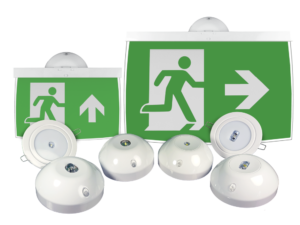
Emergency lighting systems have evolved over time to meet the changing needs of buildings and people and technological advancements. These systems are crucial for ensuring safety during power outages or emergency situations, as they provide illumination to help people navigate and evacuate buildings safely. Designed to activate automatically when the main power supply fails, emergency lighting allows occupants to exit the premises quickly and safely.
In many jurisdictions, building codes and regulations mandate the installation of emergency lighting systems. In the UK, it is part of the duty of care that all “emergency routes and exits requiring illumination must be provided with emergency lighting of adequate intensity in the case of failure of their normal lighting.”
Depending on the building, emergency escape illumination will have specific requirements, which will take over from normal lighting in the event of a power outage. Regulations and rules vary from country to country.
We talked to Richard Wharram, Exports Sales Manager at Hochiki Europe, a leader in global life safety, to shed some light on the company’s new FIREscape Nepto, its latest emergency lighting solution, and how the company is making it available to the fire and security market internationally.
Benchmark Magazine: What are the key features of FIREscape Nepto emergency lighting?
RW: FIREscape Nepto is the next evolution of our ground-breaking emergency lighting system. It is a centrally controlled, addressable, self-testing, self-monitoring emergency lighting system.
The concept is simple. There is a control panel and keypad where all the luminaires are connected to, each luminaire is a self-contained unit with a NiMH battery. The luminaires are monitored, tested and charged across an extra low voltage line (40 VDC). The control panel can support up to two lines and each line can support up to 127 devices.
All the surface-fitted luminaires mount onto Hochiki’s common mounting base making installation easy, quick and efficient.
As the system is centrally controlled, it can take inputs from almost anything and create cause-and-effect programming to allow the luminaires to be illuminated either in an emergency or for other purposes.
The FIREscape Nepto range includes various components such as luminaires, exit signs, control panels, and monitoring software.
BM: Compared to other emergency lighting solutions, what makes FIREscape Nepto stand out?
RW: The FIREscape Nepto system is networkable to up to 12 panels, so full cross-site cause-and-effect programming can be implemented. The system can be controlled across 12 panels from one keypad, but it can also have up to 12 keypads per panel.
FIREscape Nepto is more energy efficient. The change from the replaceable Li-ion batteries to the built-in NiMH batteries has meant that there is now an expected design life of 10 years for each luminaire. The new system has also improved the lighting output of the luminaires.
FIREscape Nepto is backwards compatible with its predecessor, meaning that it’s possible to mix luminaires and panels between the new and previous range. This ensures a seamless system life is maintained for existing FIREscape customers.
The system is self-testing and self-monitoring, so the end-user has peace of mind that the system is always operational. It also eliminates the need to have someone on-site to maintain the system, remembering to test the emergency lighting every month.
Being built on Hochiki’s reliable Enhanced Systems Protocol (ESP) fire protocol, it means FIREscape Nepto is an extremely intelligent, adaptable and, most importantly, reliable emergency lighting system.
BM: Are there any plans to introduce new features or enhancements to FIREscape Nepto in the near future?
RW: Yes, there are lots of exciting developments coming for our emergency lighting solution.
First, cloud reporting and testing will soon be available through our Systems Partner network, and we look forward to enhancing the system further. The new technology will allow our partners to monitor all their sites remotely.

For customers who operate in harsh environments, we are developing an IP66 weatherproof luminaire enclosure that will greatly benefit these more complex applications.
In 2024, we will be releasing re-designed high-powered luminaires, these will be a direct replacement for our current units and reduce the overall size of the fittings without compromising on light output.
BM: Could you explain the export sales strategy of FIREscape Nepto?
RW: We have been working with our key installers where there is a direct end-user benefit, for example, many of our customers are looking at ways to reduce their energy consumption. In response to this, we have designed the system to be low energy, with a low CO2 footprint so it is an ideal choice for the current issues around energy costs. It will help businesses to reduce their overall environmental impact.
FIREscape Nepto is also great for projects requiring life safety solutions with minimal maintenance. As previously mentioned, this system will automatically notify if there is any issue, so it maintains itself at 100% operation. This new feature can benefit greatly from sites where manual testing is particularly difficult to test during normal working hours, such as hospitals, factories, offices and schools.
BM: Which markets would benefit from FIREscape Nepto features internationally?
RW: FIREscape Nepto is particularly well suited to government buildings, schools, universities, hospitals and offices. But it can be used in almost any situation where traditional emergency lighting is used.
Complex buildings lend themselves to an intelligent lighting system like this, which can be programmed and configured to the site’s exact requirements. For example, allowing for a change of use in parts of the building to be reflected in the system programming without any complex and costly re-wiring.
BM: How do you identify and evaluate potential distributors or partners in the export markets?
RW: At Hochiki, we like to build partnerships with our customers and develop sales together. We already have several routes to market with our existing partners. However, we are always looking at new possibilities. Prior experience in the market, high technical ability and reputation are important, but so too is the desire to push an innovative product that raises the life safety standards for the public.
BM: What are your main challenges in expanding export sales for FIREscape Nepto?
RW: The export markets can be quite different to the UK market, with many regional differences in life safety approaches.
A centrally controlled addressable self-testing system offers long-term savings, despite its higher upfront cost. Automation reduces labour costs and minimises disruptions caused by manual inspections. Detecting faults early helps prevent costly repairs or replacements.
When looking at the total cost of ownership of an emergency lighting system over, say a 10-year period, including installation, maintenance and running costs, a more technologically advanced system such as FIREscape Nepto proves to be a much more cost-effective solution.
BM: Do international markets require specific certifications or regulations?
RW: Obviously, this is a major consideration for Hochiki. Across Europe, the voltage is fairly standard, the system only has one real connection with the mains electricity, which is at the central control panel.
All other interaction with mains voltage is at the distribution boards where we monitor the voltage.
The luminaires run

on a 40 VDC line that powers, charges and monitors the luminaires and other field devices.
Any additional local electrical requirements in Europe fall under the EN standards that the system has been designed to. In other locations globally, the certifications required have or are in the process of being obtained.
BM: How do you support or train your distributors?
RW: We provide full training on the system, which is always available free of charge to our partners and distributors’ customers.
This includes understanding the system and its components and hands-on technical product training, including system programming. We recommend that this is carried out at our purpose-built training facility in Gillingham, Kent. However, training can also be delivered at our customer’s premises.
BM: Which trends or developments do you see in the global emergency lighting market, and how will FIREscape Nepto help?
RW: There is a growing demand for self-testing systems. Also, the additional requirements of being able to record maintenance checks, report remotely and automatically send notifications to both maintenance personnel and building owners are becoming increasingly desirable as the world around us becomes ever more interconnected.
FIREscape Nepto already has many features that make it the best choice for intelligent emergency lighting. When the cloud reporting function is added later this year, FIREscape will provide all the features customers have requested.
BM: How do you stay on top of evolving customer needs when it comes to emergency lighting?
RW: We are a global business with teams across the UK and mainland Europe, the Middle East, the Indian sub-continent, Asia Pacific and Australia; plus, of course, there is our parent company in Japan and sister company in the USA. We share best practices, and our teams work closely with all our international customers, where their demands and requirements are fed back into our product development process. We also keep a close eye on developments outside of our business and even our industry – for example, looking at how technological developments in other sectors might be able to be adopted in fire safety and ultimately benefit our customers.
The FIREscape Nepto system, as with all our systems and devices, has been designed to be as adaptable and flexible as possible to be able to meet the requirements and standards of many regions.
BM: Are there any examples of FIREscape Nepto being implemented internationally?
RW: FIREscape Nepto was launched in April 2023, so most of the projects where it has been specified are still in the construction phase.
However, the predecessor to FIREscape Nepto has been installed in many locations, including universities, hospitals, hotels, government buildings etc. Notable sites are Dublin Airport, The Grand Hotel Brighton, Eurovetrocap (a glass and plastic packaging plant), Milan, Italy, Teesside University, Durham University, and Sligo Regional Hospital Ireland, to name a few.
To find out more click here


